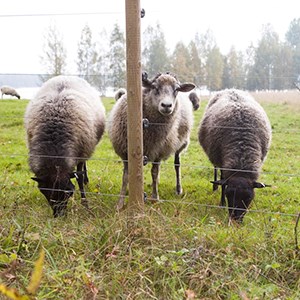Interventions to prevent carnivore attacks on domestic animals– the importance of listening to the intended end users

In her PhD project, Ann Eklund has investigated how sheep owners, transhumance farmers, hunters with dogs, reindeer herders and pet dog owners perceive interventions intended to reduce the risk and severity of carnivore attacks. She has seen that for domestic animal owners to use interventions – the interventions must work in their everyday life and be considered ethical. This is interesting to read - not least for representatives of the authorities that support animal owners with interventions.
“Representatives of the authorities must be willing to listen to the individual animal owner and try to understand the owner’s situation and concerns. If animal owners’ perceptions are ignored, then there is a risk that the authorities suggest interventions which are perceived as irrelevant, have implications with which the animal owners cannot cope, or that are incongruent with the animal owners’ norms. Then there is a risk that frustration will increase and could fuel social conflicts over carnivore management” says Ann Eklund, at the department of Ecology, Swedish University of Agricultural Sciences.
Together with her colleagues, she received a lot of attention for a study showing that there are few scientific publications that evaluate intervention effectiveness and it is difficult to say how efficiently the interventions protect domestic animals from carnivore attacks. This does not necessarily mean that the available interventions are useless, but we cannot be sure how large their effect is. Currently, most evaluations are of enclosures to keep livestock confined when carnivores are most active, livestock guarding dogs, carnivore deterrents, and to some extent removal of carnivores.
In a web-based survey to 1 286 hunters with dogs, pet dog owners, reindeer herders, sheep owners, and transhumance farmers, it was apparent that a belief in the intervention effect is a prerequisite to acceptance of the interventions. That was also highlighted during 11 group interviews with animal owners. Just like the researchers, animal owners conclude that the knowledge of intervention effectiveness is currently limited.
But interventions can be opposed although the animal owners believe them effective. The intervention may for instance be difficult to implement in their everyday life, or be expensive and be time consuming. In such cases, the authorities may be able to facilitate intervention use by providing economic support or fund labour.
Sometimes the implications of intervention use are more difficult to handle. Animal owners may be concerned that the intervention will be a nuisance to other people. Sound deterrents may cause disturbance to neighbours, and carnivore deterring fences or aggressive guard animals may limit the right of free movement. Not least are animal owners concerned for their own animals’ well-being. Confining sheep or keeping reindeer in enclosures can lead to higher risks of parasites and diseases. Hunting dogs that wear protective vests may bruise, get caught in the terrain, or overheat.
Finally, an intervention must also be considered ethical, just, and compliant with legislation to be accepted. Transhumance farmers that keep their animals free ranging in the forest may perceive a risk violating the legislation of dog supervision if they use livestock guarding dogs. Sheep owners who regard dogs as family members may find it unethical to leave the livestock guarding dog in the field with the sheep herd. Similarly, a reindeer herder may find it unethical to chase a carnivore from the herd and see it struggle in the deep snow without a clear plan for where it should go.
In such instances it does not really matter how effective the animal owner believes that the intervention is. It will still not be acceptable for the person to use it.
However, specific interventions may be more or less acceptable to individual animal owners.
“Representatives of the authorities have an important role. If they succeed to work with the animal owners and support the use of interventions with consideration to the animal owner’s situation, then there is a possibility to facilitate coping with experienced worry for carnivore attacks. The interventions may then support a future for large carnivores and animal husbandry in coexistence”, says Ann Eklund.
Contact: Ann.Eklund@slu.se